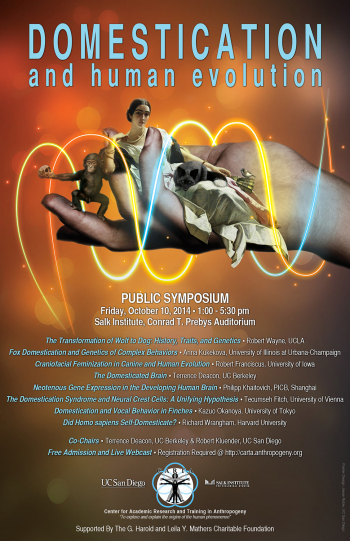Domestication and Human Evolution
Terrence Deacon, University of California, Berkeley
Robert Kluender, University of California, San Diego
The domestication of other species has played an undeniably central role in the evolution of modern humans, and in our planetary dominance and success. In view of this fact, researchers have over the years investigated the genetic underpinnings and the anatomical, neural, physiological and behavioral consequences of domestication across a number of animal species – but largely independently of each other. Recently, a convergence of views has led to the notion that the study of animal domestication may tell us something not only about our relationship with domesticated species since perhaps at least the Pleistocene, but also about our own evolution as a species in the more distant past. Specifically, it has been suggested that a number of the unique anatomical, neural, developmental, social, cognitive and communicative traits that define our species may be attributable to selection for lack of aggression and to a process of self-domestication. This symposium brings together researchers from a variety of research backgrounds to examine these concepts and to elucidate further the possible role of domestication in human evolution.
Media for each talk can be played by clicking on icons in the table below, or by clicking on the individual talk titles below and then the attachment file at the bottom of the page.
| Speakers | Media | Session |
|---|---|---|
 Fred Gage |
|
Welcome and Opening Remarks |
 Robert Kluender |
|
Introduction |
 Robert Wayne |
|
The Transformation of Wolf to Dog: History, Traits, and Genetics The dog may be our most diverse and remarkable living invention. The diversity of dogs in size and proportion exceeds that of the entire carnivore order, including more than 270 species. Functional diversity is also impressive, with specific dog breeds having enhanced sensory, locomotor and cognitive abilities. However, perhaps the most meaningful attribute of dogs is their eagerness to do useful work for humans. These tasks are as varied as their form, including guarding, rescue, warfare,... read more |
 Anna Kukekova |
|
Fox Domestication and Genetics of Complex Behaviors Domestication as a special form of evolution offers valuable insight into how genomic variation contributes to complex differences in behavioral and morphological phenotypes. The genetics-centered view of the domestication is supported by experimental selection of farm-bred foxes (Vulpes vulpes) that begun at the Russian Institute of Cytology and Genetics in the 1950s. Selection of foxes, separately, for tame and for aggressive behavior, has yielded two strains with markedly different,... read more |
 Robert Franciscus |
|
Craniofacial Feminization in Canine and Human Evolution Anatomically modern humans are recognized in the fossil record primarily by retraction and diminution of the facial skeleton compared to pre-modern “archaic” humans. Several explanatory models for this facial “gracilization” shift have been proposed, all of which have theoretical or empirical shortcomings. The last 200,000 years of human cultural evolution have also witnessed initially ephemeral occurrences of innovation, planning depth, and abstract and symbolic thought (i.e., “behavioral... read more |
 Terrence Deacon |
|
The Domesticated Brain The brains of domestic animals tend to share a number of traits in common. Perhaps the most common trait is relative reduction of overall brain size in domestic as compared to wild ancestors, though this is not always present with domestication, and is often complicated by changes in overall body size. Reduction of size is not uniformly represented in all brain structures and tends to disproportionately affect a fairly consistent set of structures. These tend to be telencephalic structures and... read more |
 Philipp Khaitovich |
|
Neotenous Gene Expression in the Developing Human Brain Human evolution has resulted in a species that possesses an apparently unique set of phenotypic capabilities. In our laboratory, we search for molecular features specific to humans, through integrative analysis of genetic, transcriptomic and metabolomic data measured in modern and archaic humans, as well as closely related mammalian species: chimpanzees, macaques and mice. Following this approach, we have identified human-specific delay in timing of neocortical synaptogenesis as one of... read more |
 W. Tecumseh Fitch |
|
The Domestication Syndrome and Neural Crest Cells: A Unifying Hypothesis Charles Darwin was the first to notice that all of the mammals domesticated by man show an unusual suite of traits not found in their wild forebears. These include changes in pigmentation (e.g. white spots), short snouts, smaller teeth, and floppy ears. My colleagues Adam Wilkins and Richard Wrangham and I have suggested that the origin of this odd collection of phenotypic variants lies in their embryological origins in the neural crest. The neural crest is a transitory embryonic tissue that,... read more |
 Kazuo Okanoya |
|
Domestication and Vocal Behavior in Finches Bengalese finches (BFs) are a domesticated strain of wild white-rumped munias (WRMs) imported from China to Japan 250 years ago. BF songs are composed of multiple chunks. Each chunk is a combination of 2-4 song notes. Chunks are arranged in a syntactic rule. We studied how and why BFs sing such complex songs. We found the following facts. 1). WRMs sing simpler songs. 2). There is high learning specificity in WRMs but not in BFs. 3). BFs have larger brain structures related with song than WRMs.... read more |
 Richard Wrangham |
|
Did Homo Sapiens Self-Domesticate? “Self-domestication” here refers to the evolution of a reduced propensity for reactive aggression (compared to an immediate ancestor), without the active involvement of another species. Animal species that have been domesticated by humans all have low reactive aggression and also tend to share a suite of behavioral, physiological and anatomical symptoms (the “Domestication Syndrome”). This suggests that in self-domesticated species a parallel set of features should be found (the “Self-... read more |
 Terrence Deacon  Robert Kluender |
|
Wrap-up, Question and Answer and Closing Remarks |
| Attachment | Size |
|---|---|
| 1.31 MB | |
| 795.23 KB | |
| 271.67 KB | |
| 1.4 MB |
If you enjoy this event, please consider supporting CARTA's quest to explore and explain the human phenomenon.


